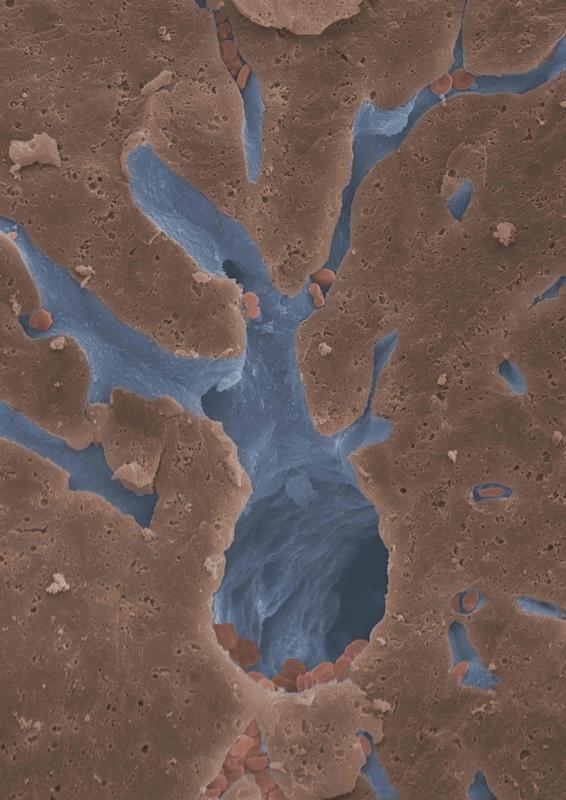Increased Blood Flow triggers Liver Regeneration

An illustration of an artificially stained blood vessel is shown. It is a scanning electron micrograph of a hepatic blood vessel. The image was taken and edited by Dr. Daniel Eberhard (Institute of Metabolic Physiology, HHU) and S. Köhler (Center for Advanced Imaging, HHU).
The liver is one of the most important human organs. It is essential for metabolism, blood detoxification and the functioning of the immune system. Moreover, the liver is the only organ which can fully regenerate its cell mass within a few weeks after more than half of the organ has been removed.
The researchers led by Professor Eckhard Lammert have discovered that it is due to increased blood flow and subsequent dilation of the liver vasculature that the liver receives signals for growth. The signals come from the cells of the blood vessels that react to the mechanical stimulation. The publication is based on the findings published in 2001 that blood vessels affect organs in their function and growth (Lammert et al., Science 2001).
“In our study of the liver and its blood vessels, we identified an important trigger for organ growth. For the first time, we were able to show that blood flow and vasodilatation release growth-promoting signals from blood vessels,” said Professor Eckhard Lammert, director of the Institute for Beta Cell Biology at the German Diabetes Center (DDZ) and head of the Institute for Metabolic Physiology at Heinrich Heine University Düsseldorf.
“In the future, these exciting results could also become important for the understanding and treatment of fatty liver disease in obesity and diabetes,” added Professor Michael Roden, scientific director and board member of the German Diabetes Center and director of the Department of Endocrinology and Diabetology at Düsseldorf University Hospital.“
The research results are of great importance for understanding the complex processes involved in liver regeneration and its disorders,“ said Professor Dieter Häussinger, director of the Department of Gastroenterology, Hepatology and Infectious Diseases at Düsseldorf University Hospital and spokesperson of the Collaborative Research Center 974.
Experimental Procedure
The molecular causes of this organ regeneration are the subject of a study published by Düsseldorf scientists in the journal Nature (Lorenz et al., Nature 2018). Specifically, the scientists were able to show that increased blood flow through the liver leads to the release and activation of growth signals from blood vessels.
One of these signals is the hepatocyte growth factor (HGF), which is particularly important for the growth and survival of liver cells. The endothelial cells of the blood vessels recognize the increased blood flow through the liver by means of so-called integrins.
These are cell surface proteins that connect the extracellular matrix to the cytoskeleton and are able to activate other receptors such as the vascular endothelial growth factor receptor-3 (VEGFR3). The activation of the β1 integrin (a subunit of the integrins) due to the increased blood flow leads in endothelial cells to the activation of VEGFR3 and the activation and release of growth factors such as HGF. The latter induce the growth of the liver.
As soon as the liver has grown to its normal size and new blood vessels have formed, a normal amount of blood per endothelial cell flows through the liver again. This normal mechanical stimulation of the endothelial cells could explain why the liver stops growing. The scientists postulate that this molecular mechanism causes the liver to grow as soon as its organ size is reduced and then to stop growing when it is restored.
Prof. Dr. Eckhard Lammert
Institut für Stoffwechselphysiologie
Heinrich-Heine-Universität Düsseldorf
Universitätsstraße 1
40225 Düsseldorf
Tel.: +49 211 81-13234
Lorenz L, Axnick J, Buschmann T, Henning C, Urner S, Fang S, Nurmi H, Eichhorst N, Holtmeier R, Bódis K, Hwang JH, Müssig K, Eberhard D, Stypmann J, Kuss O, Roden M, Alitalo K, Häussinger D, Lammert E. Mechanosensing by β1 integrin induces angiocrine signals for liver growth and survival. Nature. 2018 Sep 26. doi: 10.1038/s41586-018-0522-3.
https://figshare.com/s/f7ceb9d5980d10084ad8
http://ddz.uni-duesseldorf.de/en/
Media Contact
All latest news from the category: Life Sciences and Chemistry
Articles and reports from the Life Sciences and chemistry area deal with applied and basic research into modern biology, chemistry and human medicine.
Valuable information can be found on a range of life sciences fields including bacteriology, biochemistry, bionics, bioinformatics, biophysics, biotechnology, genetics, geobotany, human biology, marine biology, microbiology, molecular biology, cellular biology, zoology, bioinorganic chemistry, microchemistry and environmental chemistry.
Newest articles

Properties of new materials for microchips
… can now be measured well. Reseachers of Delft University of Technology demonstrated measuring performance properties of ultrathin silicon membranes. Making ever smaller and more powerful chips requires new ultrathin…

Floating solar’s potential
… to support sustainable development by addressing climate, water, and energy goals holistically. A new study published this week in Nature Energy raises the potential for floating solar photovoltaics (FPV)…

Skyrmions move at record speeds
… a step towards the computing of the future. An international research team led by scientists from the CNRS1 has discovered that the magnetic nanobubbles2 known as skyrmions can be…





















